New Mexico Range Plants
Circular 374
Revised by Christopher D. Allison and Nick Ashcroft, November 2011.
Reviewed by Casey Spackman, November 2023.
College of Agricultural, Consumer and Environmental Sciences, New Mexico State University
Authors: Respectively, Range Management Specialist and Department Head; and Range Management Specialist, both of the Department of Extension Animal Sciences and Natural Resources, New Mexico State University. (Print-friendly PDF)
Table of Contents
Rangeland Areas of New Mexico
Grasses
Forbs
Trees and Shrubs
New Mexico contains almost 78 million acres, more than 90 percent of which is in native vegetation grazed by domestic livestock and wildlife. The kinds of plants that grow on a range, along with their quality and quantity, determine its value. A successful rancher knows the plants on his or her range.
There are more than 3,000 species of plants in New Mexico. The 85 discussed here are most important to the livestock industry. Most of these are native plants.
Rangeland Areas of New Mexico
Figure 1 represents the major rangeland areas in New Mexico. The northern desert, western plateau, and high valley areas are enough alike to be described together, as are the central and high plains areas and the southern desert and basin.

Figure 1. New Mexico rangeland areas. (Source: USDA-NRCS. Used with permission.)
Southern Desert and Basin
The southern desert and basin occupies much of southern New Mexico at elevations between 3,000 and 5,000 feet. This area follows the Rio Grande north into the southern part of Sandoval County.
Some of the most common plants are creosote bush (Larrea tridentata [DC.] Coville), mesquite (Prosopis glandulosa Torr.), cacti (Opuntia spp.), black grama (Bouteloua eriopoda Torr.), tobosa (Hilaria mutica [Buckl.] Benth.), and dropseeds (Sporobolus spp.). Much of the southern desert area now occupied by creosote bush and mesquite once produced mostly black grama and other valuable grasses (Figure 2). The combination of overgrazing and drought over the past 100 years has worked to the advantage of undesirable shrubs.
Precipitation is less than 12 inches annually and variable. Most of it comes during July, August, and September. Forage production is usually low and uncertain, so that range management is quite difficult.

Figure 2. Creosote bush and mesquite dominate much of the range in the southern desert region.
Northern Desert, Western Plateau, and High Valley
The northern desert, western plateau, and high valley region of northwestern New Mexico receives about 10 to 14 inches of precipitation annually. The average elevation is around 5,500 to 6,000 feet.
In the northern desert, big sagebrush (Artemisia tridentata Nutt.), fourwing saltbush (Atriplex canescens [Pursh] Nutt.), and winterfat (Ceratoides lanata [Pursh] J.T. Howell) are the most important shrubs (Figure 3). Big sagebrush is most common where soils are alkali-free, and it spreads in areas of grazing abuse. Fourwing saltbush and winterfat are desirable browse plants. Western wheatgrass (Agropyron smithii Rydb.) and blue grama (Bouteloua gracilis [H.B.K.] Lag.) are common understory forage grasses.

Figure 3. Livestock graze crested wheatgrass that was seeded following big sagebrush control on a northern desert range.
At the higher elevations of the western plateau, piñon pine (Pinus edulis Engelm.) and several species of juniper (Juniperus spp.) occupy mostly rocky ridges and shallow soils (Figure 4). These plants have also moved into some of the better grassland soils. In the open areas, sideoats grama (Bouteloua curtipendula [Michx.] Torr.), blue grama, and galleta (Hilaria jamesii [Torr.] Benth.) are important understory forage plants. The lower elevations are dominated by blue grama.

Figure 4. Piñon and juniper species occupy shallow soils at higher elevations in the western plateau.
Central and High Plains
Much of the eastern half of the state lies in these two rangeland resource areas. The elevation averages between 4,500 and 5,000 feet over most of the region. The mean annual precipitation is between 14 and 18 inches, with about 70 percent coming between April and September.
Most of the central and high plains is short-grass country, dominated primarily by blue grama (Figure 5). Sideoats grama, hairy grama (Bouteloua hirsuta Lag.), and galleta are also prominent in some areas, especially on coarser soils and gravelly slopes. Big bluestem (Andropogon gerardii Vitm.) sometimes dominates heavier soils that receive additional run-in water, and sand bluestem (A. hallii Hack.) is found on sandy soils. Little bluestem (Schizachyrium scoparium [Michx.] Nash) is common on coarse soils and rocky slopes.

Figure 5. The central and high plains give an aspect of a sea of grass.
Buffalograss (Buchloe dactyloides [Nutt.] Englem.) occupies heavy soils, especially in the extreme northeast part of the state. In the southern parts, vine-mesquite (Panicum obtusum H.B.K.) is important on the heavy, adobe soils. The alkali soils of meadows, valleys, and flood plains are dominated by alkali sacaton (Sporobolus airoides Torr.).
Short-grass ranges that are grazed moderately are highly productive.
Mountains
The high mountain areas of the state provide grazing in the subalpine meadows and openings of the forests (Figure 6). The meadows occur in parklike openings mostly above 9,000 feet and have an annual precipitation from 30 to 35 inches. Fescues (Festuca spp.) are common grasses in the subalpine meadows, as well as sedges (Carex spp.) and rushes (Juncus spp.).

Figure 6. Openings in the forest provide much of the grazing in the mountain areas.
The ponderosa pine (Pinus ponderosa Lawson) forests grow at elevations from 6,500 to 11,500 feet, with an annual precipitation from 20 to 30 inches. In the dense forests, there is very little herbaceous understory, but where the forest canopy is relatively open, herbaceous forage plants are common. Most important are Arizona fescue (Festuca arizonica Vasey.) and mountain muhly (Muhlenbergia montana [Nutt.] Hitchc.). Blue grama is also prominent but less productive, especially on overgrazed mountain ranges (Figure 7).

Figure 7. Cholla, juniper, and blue grama are typical of many transitional areas between the central plains and mountainous areas.
Grasses
Western Wheatgrass
Agropyron smithii Rydb.
DescriptionModerately coarse. One to 2 1/2 feet tall. Spreads by long, slender rhizomes. Blue-green when growing. Leaves are erect and have conspicuous ridges on the upper surface.
Cool-season, perennial, sod grass.
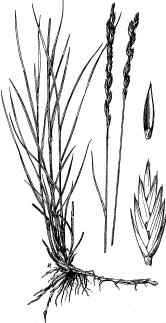
Occurrence
Widespread throughout the state from 3,000 to 10,000 feet. Most abundant on bottomland and mountain grassland sites. Grows best on rather heavy soils with runoff water. Tolerant of moderately alkaline soils.
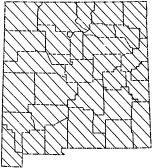
Forage Value and Management
Western wheatgrass provides early green forage before warm-season grasses begin growth. It is palatable to all livestock. The grass produces moderately large amounts of forage and cures well on the ground. Sheep like the seedheads. The grass withstands light grazing in the spring. Heavier grazing reduces its vigor and forage production.
Slender Wheatgrass
Agropyron trachycaulum (Link) Malte.
Description Rather coarse. Moderately leafy. One to 3 feet tall. Bluish with violet seedheads. The leaves, somewhat rough to the touch, are 2 to 10 inches long and flat or slightly inrolled at the edges. Seedheads, 2 to 8 inches long, are slightly flattened spikes.
Cool-season, perennial, bunch grass.
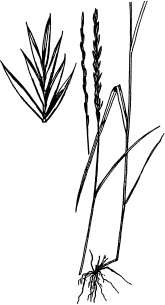
Occurrence
Mountain areas in open forests and mountain meadows at elevations from 6,000 to 10,000 feet.
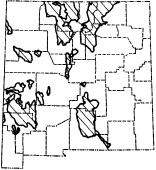
Forage Value and Management
Slender wheatgrass, one of the most palatable and nutritious wheatgrasses, is relished by all livestock. Sheep do not graze the coarse mature plants readily but like the seedheads.
The grass begins to grow early in the spring and continues through the summer if moisture is available. Under moderate grazing, the plant will maintain itself.
Redtop
Agrostis gigantea Roth
Description
Coarse. One to 3 feet tall. Strong rhizomes. Numerous flat leaves about 1/4 inch wide and mostly basal. The leaf is harsh to the touch with a prominent ligule. The seedhead is a purplish-red loose panicle, pyramid-shaped, 4 to 12 inches long.
Introduced from Europe as a cultivated species. Cool-season, perennial, sod grass.
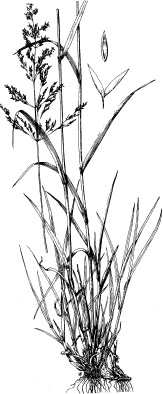
Occurrence
Mostly in mountain meadows and subalpine grasslands where openings in the tree canopy occur. Also in wet meadows in the western plateau and central plains. Ranges in elevation from 5,000 to 10,000 feet, but most common at 7,500 feet.
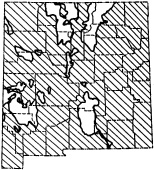
Forage Value and Management
Redtop is palatable to cattle and horses, and sheep will graze it if necessary. When moisture is adequate, the plants remain green all summer and can be grazed throughout the season. Redtop grows vigorously and forms good sod. Because of this, on its preferred sites, the plant withstands heavy use and serves well as a soil binder for reclaiming gullies and holding slopes and banks. It is well adapted to wet acid soils.
Big Bluestem*
Andropogon gerardii Vitm.
Description
Large, 3 to 4 feet tall, sometimes 6 feet under favorable conditions. Short, thick rhizomes. Growing leaf blades are bluish green, usually tinged with red or purple, cure to reddish purple. Leaf blades 4 to 18 inches long with rough margins and fine hairs near the base. Seedheads have 2 to 6 branches (usually 3, resembling a turkey foot) and are covered by bent, twisted awns 1/2 to 1 inch long.
Warm-season, perennial, sod or bunch grass.
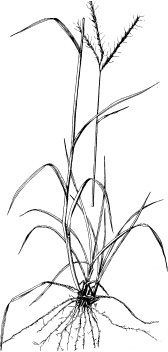
Occurrence
Restricted to sites with good moisture in the high plains, central plains, and mountain areas from 3,500 to 9,000 feet in elevation.
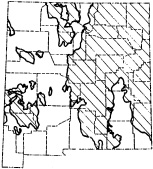
Forage Value and Management
Big bluestem, highly palatable to all livestock during the spring and early summer, becomes coarse later in the growing season. It cures well when cut for hay. Stands decrease under heavy grazing, and therefore indicate range conditions since the grass is most abundant on good to excellent rangeland.
*Sand bluestem, Andropogon hallii Hack., not shown, is a perennial sod grass that looks much like big bluestem, except that the awns on the seedheads are shorter and it has aggressive underground stems. It grows within the high plains, central plains, and southern desert on sandy sites from 3,000 to 7,000 feet. Sand bluestem forage value and management are similar to big bluestem.
Poverty Threeawn
Aristida divaricata Henr.
Description
Tall, 1 to 3 feet high. Dark green, curing to straw. Leaves up to 6 inches long, inrolled, and spirally twisted when dry. Seedheads open with spreading branches. Each seed is tipped with three spreading awns.
Warm-season, perennial, bunch grass.
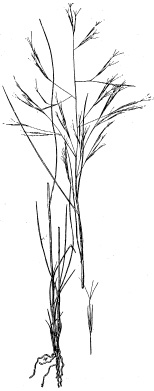
Occurrence
Occurs throughout the state. Typical of poor, rather sterile soils at elevations of 3,100 to 7,000 feet.
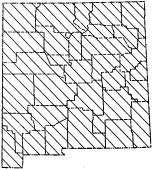
Forage Value and Management
The palatability of this grass before the seed matures is rated low to moderate for all livestock. After the troublesome seeds have matured, its forage value is negligible. Poverty threeawn produces the most forage after spring rains.
Rangelands supporting abundant poverty threeawn may afford spring grazing not obtained from other grasses. Since this grass tends to increase under heavy use, grazing management is based on the more productive associated grasses.
Red Threeawn
Aristida longiseta Steud.
Description
Densely tufted. Six to 20 inches tall. In heavy clumps. Green, curing to tan. Old leaves from previous years cause the growing plants to appear grayish-green. Leaves, less than 6 inches long, inrolled, and harsh on the upper surface. Seed stalks usually short and branched. Seeds, tipped with three awns, 2 to 3 inches long, and red when immature.
Warm-season, perennial, bunch grass.
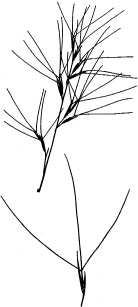
Occurrence
Throughout the state at elevations of 3,100 to 7,000 feet. Most abundant in the southern desert, high plains, and central plains. Typical of dry sandy or gravelly plains and uplands.

Forage Value and Management
The palatability of this species when green is low to moderate for all livestock. The grass has little value when dry. Although growth begins in the late spring, little forage is produced until the summer rains.
Red threeawn increases under heavy grazing because it is less palatable than associated grasses. The grass may indicate an overgrazed range, but it may also indicate a dry, well-drained soil.
Deep soils supporting extensive stands of red threeawn can be improved through light, winter, or deferred grazing. Before reseeding can be successful, red threeawn must be removed.
Pine Dropseed
Blepharoneuron tricholepis (Torr.) Nash
Description
Fine-stemmed. Erect. One and a half to 2 1/2 feet tall. Deep, fibrous root system. Bright green to light grey-green. Leaves abundant, narrow, and usually short. Seedheads 3 to 9 inches long, slender, grayish, and somewhat open.
Warm-season, perennial, bunch grass.
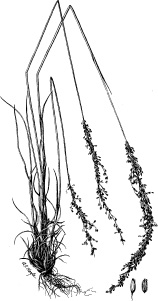
Occurrence
Mountain areas at 6,500 to 10,000 feet.
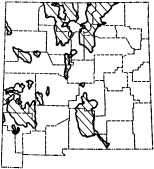
Forage Value and Management
Young, tender pine dropseed is highly palatable to all livestock. After maturity, the stems are grazed only slightly.
The plant should be grazed during the summer. In the grass composition of mountain rangeland, it indicates good range condition.
Cane Bluestem*
Bothriochloa barbinodis (Lag.) Herter
Description
Coarse. Two to 4 feet tall. Blue-green, drying to reddish-brown with lighter leaf midribs. Tufts of bright silvery hair form fan-shaped seedheads on the ends of long seed stalks. Stem nodes, encircled with hairs.
Warm-season, perennial, bunch grass.

Occurrence
Common within the southern desert region on west sites. Found on bottomland sites in the central plains, high plains, and western plateau. Occurs at 3,000 to 7,000 feet.
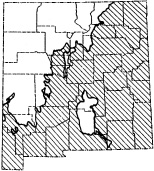
Forage Value and Management
Actively growing cane bluestem provides fair to good forage for cattle and sheep. Dry plants are low in nutrients as they leach readily. The grass is a good indicator of range condition because it rapidly decreases under improper use.
*Sliver bluestem, Bothriochloa saccharoides (Swartz.) Rydb., is much like cane bluestem. The information given for cane bluestem also applies to silver bluestem.
Sixweeks Grama*
Bouteloua barbata Lag.
Description
Relatively short-lived. Three to 15 inches tall. Stems spread along the ground before turning upward. Light green, curing to straw. Very few leaves. Seedheads comb-like spikes borne on the sides of the seed stalks, usually 4 to 7 seedheads per stalk.
Warm-season, annual, bunch grass.
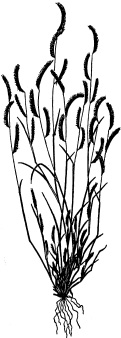
Occurrence
Scattered throughout the western and southern portions of the state. Typical on coarse-soiled breaks, slopes, and washes. Grows below 7,000 feet.

Forage Value and Management
The forage value of sixweeks grama is low. The green period is short, little forage is produced, and the plants are easily uprooted when grazed because the root system is weak. The plant is practically worthless after maturity.
Ranges with abundant annual grasses, such as sixweeks grama, become productive a few weeks after the summer rains. These areas will remain productive for about two months and can be heavily stocked during this period, as they will deteriorate rapidly.
*Needle grama, Bouteloua aristidoides (H.B.K.) Griseb., occurs in association with sixweeks grama, especially in southern New Mexico. It has the same forage value and management characteristics as sixweeks grama.
Sideoats Grama
Bouteloua curtipendula (Michx.) Torr.
Description
Largest grama, 15 to 30 inches tall. Leaves mostly basal, coarse, usually bluish-green in the spring and straw in the faIl. The seedheads have 10 to 30 small spikes attached to one side of the seed stalk.
Warm-season, perennial, bunch grass.
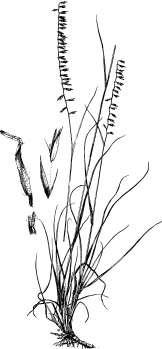
Occurrence
Widely distributed. Common on most sites throughout the state from 3,000 to 9,000 feet. Grows best on alluvial soils but is also typical of dry slopes, ridges, and rocky hillsides.
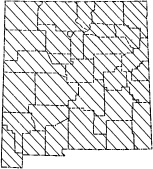
Forage Value and Management
Sideoats grama is palatable and productive. It grows earlier in the spring and later in the fall than blue grama. Sideoats grama maintains a fairly high feeding value throughout the year.
Due to its high palatability, the species is soon killed by overgrazing. Many ranges that formerly had large quantities of this grass now produce little.
Black Grama
Bouteloua eriopoda Torr.
Description
Tangled, with crooked, woolly stems. One to 2 feet tall. Grayish green, curing to gray. Stem bases covered with fine white fuzz. Stem joints enlarged and frequently take root. Leaves narrow, less than 1/8 inch wide, and 1 to 5 inches long, inrolled, and wavy. Usually 4 to 5 comb-like spikes on the sides of the seed stalks. The spikes are narrow and persistent.
Warm-season, perennial, sod grass.
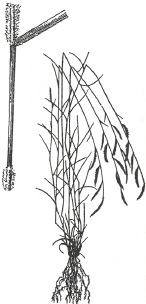
Occurrence
Throughout the southern desert and common on sandy and shallow sites of most other areas below 7,000 feet.
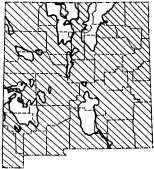
Forage Value and Management
Black grama is one of New Mexico's most valuable and nutritious grasses. It is highly palatable and a good forage producer, and it remains palatable and nutritious throughout the year. Because it cures well and the stems remain green near the ground, black grama is well adapted to fall, winter, spring grazing. Heavy summer grazing often prevents reproduction by tillers and stolons.
Black grama often indicates range condition and utilization. The lack of stolons, uniform cropping below a 2-inch height, and almost no flower stalks indicate over-use. When black grama is used properly, associated plants will also grow well.
Blue Grama
Bouteloua gracilis (H.B.K.) Lag.
Description
Low-growing, 6 to 12 inches tall, with seed stalks occasionally reaching 4 feet. Grayish-green curing to gray or straw yellow. Leaves basal, fine, 2 to 5 inches long, with hairs at the junction of the leaf blade and stem. Seeds most commonly in two comb-like, purplish spikes on each seed stalk.
Warm-season, perennial, sod or bunch grass.
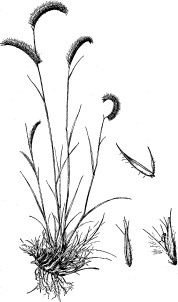
Occurrence
All areas and on most sites. Most prevalent on sands, loams, shallow sites, bottomlands, and mountain grasslands, mostly between 3,000 and 8,000 feet.
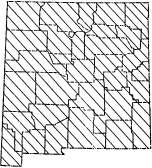
Forage Value and Management
Blue grama is highly palatable to all livestock. The species cures well and may retain as much as 50 percent of its nutritive value when dormant.
Under favorable conditions, blue grama produces abundant forage. However, under heavy grazing it tends to increase. Nearly pure stands may grow in woodlands where grazing has been severe. These stands provide poor soil protection and produce little herbage. Under these conditions, it is an inferior forage plant. At higher elevations, blue grama dominance indicates a deteriorated range, but on short-grass range, it indicates a satisfactory condition.
Hairy Grama
Bouteloua hirsuta Lag.
Description
One to 2 feet tall. Closely resembles blue grama. Bluish-green while growing, cures to gray or straw color. Leaves, fine and narrow with tiny pimple-like projections containing hairs along the margins. Hairs often found along the midrib. Comb-like flower heads, usually two, remain on leafless flower stalks throughout winter. A beak-like naked projection extends about 1/4 inch beyond flower head.
Warm-season, perennial, sod or bunch grass.
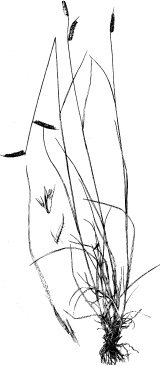
Occurrence
Throughout the state on most sites, particularly on sandy or gravelly sites at elevations of 3,000 to 10,000 feet.
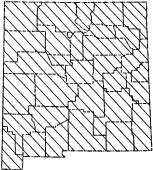
Forage Value and Management
Hairy grama is quite nutritious and moderately to highly palatable. It withstands grazing well. Because of its curing quality, hairy grama is well suited for fall, winter, and spring grazing.
Slender Grama
Bouteloua repens (H.B.K.) Scribn. & Marr.
Description
Fine-stemmed, 12 to 18 inches tall. Bright green, curing to yellow or gray. Leaves narrow and basal, curly with maturity. Three to 7 tuft-like spikes usually hang along one side of the flower stalk.
Warm-season, perennial, bunch grass.

Occurrence
Gravelly, stony, and malpais sites in the southwestern portions of the southern desert and western plateau, from 3,500 to 7,000 feet.
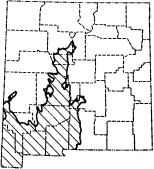
Forage Value and Management
Slender grama is highly palatable when green, moderately palatable when dry. The grass withstands grazing well, although it is relatively short-lived and not highly drought resistant.
Buffalograss
Buchloe dactyloides (Nutt.) Engelm.
Description
Low-growing. Two to 12 inches tall. Creeping surface runners take root at the leafy joints. Gray-green, curing to yellowish brown. Male and female plants grow separately. Seeds are borne by the female plant in burs clustered among the curly leaves. Male plants have two or three flaglike seedheads.
Warm-season, perennial, sod grass.
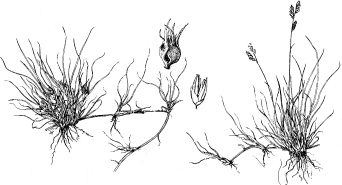
Occurrence
Most common on loamy and clayey sites in the high plains, central plains, and the southwestern tip of the southern desert, from 3,000 to 7,000 feet.
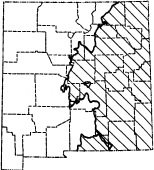
Forage Value and Management
Palatability is high for all livestock. The plant does not produce large amounts of forage. It withstands grazing well but is killed when overgrazed. The plant cures well on the ground providing good winter and early spring forage.
Bermudagrass
Cynodon dactylon (L.) Pers.
Description
Creeping turf-type, 6 to 12 inches tall. Blue-green, curing to light straw. Leaves short, flat, and often opposite one another. A prominent fringe of white hair lies at the base of each leaf. Seedheads have 3 to 8 branches in a whorled cluster. The grass spreads rapidly by surface runners and underground stems.
Introduced. Warm-season, perennial, sod grass.
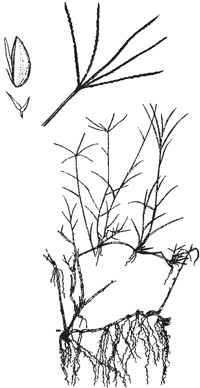
Occurrence
Widely used throughout the southern portion of the state as a lawn and pasture grass. Often found along streams and ditches where it has escaped cultivation.
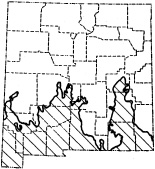
Forage Value and Management
Moderately to highly palatable for all livestock, bermudagrass grows through the spring, summer, and fall where moisture is adequate.
Bermudagrass should be grazed fairly heavily because mature growth becomes tough and wiry. Irrigated pastures should not be grazed while wet or muddy. The grass responds well to nitrogen fertilization. Animals gain best when bermudagrass is grown with some pasture legume.
Tufted Hairgrass
Deschampsia caespitosa (L.) Beauv.
Description
Erect, 2 to 4 feet tall. Bright green leaves, purplish flower head. Leaves basal, flat, folded, or occasionally inrolled, coarse, and stiff. The flower head, usually open, may be drooping, and is 4 to 12 inches long.
Cool-season, perennial, bunch grass.
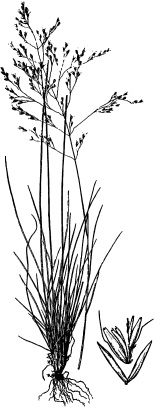
Occurrence
Moist open sites in meadows and ponderosa pine forests within mountain areas above 7,000 feet. May occur in pure stands.
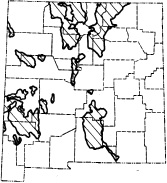
Forage Value and Management
When tufted hairgrass is growing rapidly, livestock relish it. Otherwise, it is usually moderately palatable. The grass occasionally becomes so coarse that cattle and sheep graze it only lightly. The plant withstands fairly close grazing.
Arizona Cottontop
Digitaria californica (Benth.) Henr.
Description
Slender, erect, with hard, round stems. One to 4 feet tall. Tufted, with woolly, enlarged bases. Dark bluish-green, curing to a gray or straw. Leaves, 3 to 5 inches long, loosely attached to smooth, purple stem. Long seedheads with silky, cotton-like hairs covering the spikelets. Seeds drop at maturity leaving the seedhead looking like broomstraw.
Warm-season, perennial, bunch grass.

Occurrence
Throughout the southern desert and the southern portion of the western plateau, scantily in the southern portion of the high plains and central plains. Elevations from 3,000 to 6,500 feet.
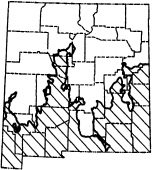
Forage Value and Management
Arizona cottontop responds quickly to summer rains and grows rapidly. It provides highly palatable green forage.
Palatability decreases as the grass matures. The plant cures well. Because of its palatability, the grass is often overgrazed. It will come back rapidly if not grazed during the summer.
Desert Saltgrass
Distichlis spicata (L.) Green var. stricta (Torr.) Beetle
Description
Low-growing, harsh, with scaly, creeping rootstocks. Blue-green to gray-green, curing to golden-brown. Leaves are wiry, usually inrolled, and sharp. Seed stalks up to 15 inches tall.
Warm-season, perennial, sod grass.

Occurrence
Common on salt flats and salty bottomlands and meadows over most of the state except mountains. Seldom found above 6,500 feet in elevation.

Forage Value and Management
Palatability is usually low to moderate for all livestock. Although somewhat harsh, desert saltgrass remains green when other grasses are dry.
Desert saltgrass is usually best grazed during the spring and fall droughts because it generally grows in damp areas and is green when upland grasses are dry.
Bottlebrush Squirreltail
Elymus longifolius (J.G. Smith) Gould
Sitanion hystrix (Nutt.) J.G. Smith
Description
Erect, up to 24 inches tall. Bright green, curing to grayish tan. Tufted, slender stems. Narrow leaves, occasionally inrolled, and often harsh on the upper surface. Seedhead long, narrow, spiked, often partly enclosed in the upper sheath, bearing bristly, crinkled awns.
Cool-season, perennial, bunch grass.

Occurrence
Scattered throughout the state, particularly in the southern desert. Reaches greatest abundance on disturbed soil. Grows at elevations from 3,000 to 10,000 feet.
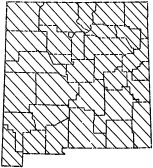
Forage Value and Management
Palatability is moderate for cattle and horses and low for sheep, in the spring and early summer before the heads develop. The plant may produce green forage in the fall if rains come, and seedheads have fallen.
Plains Lovegrass
Eragrostis intermedia Hitchc.
Description
Fairly coarse. Sixteen to 36 inches tall. Loose, spreading growth habit. Light green, curing to light straw yellow. Leaves long and slender with the blades rolled toward the upper side. Seedheads broad and open with numerous branchlets, 8 to 16 inches long and 6 to 12 inches wide.
Warm-season, perennial bunchgrass.

Occurrence
Common in the southern desert and the southwestern plateau. Typical of coarse, gravelly soils. Grows between 3,800 and 8,500 feet in elevation.
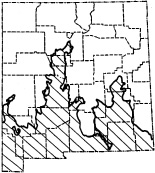
Forage Value and Management
Because of its palatability and early greening when moisture is available, plains lovegrass is often overgrazed in the spring. An abundant stand of this grass can be maintained by not grazing it until mid-summer every third or fourth year.
Fluffgrass
Erioneuron pulchellum (H.B.K.) Tateoka.
Description
Low, tufted. Three to 6 inches. May produce runners. Bluish-green, curing to a grayish-white. Densely hairy, thin, wiry leaves 1 to 2 inches long, in distinct groups at the stem base and just beneath the seedheads. Seeds form in clumps of leaves at the end of the stem. Seedheads produce thick silvery hair and retain a pair of papery bracts when seeds fall.
Warm-season, perennial, bunch grass.
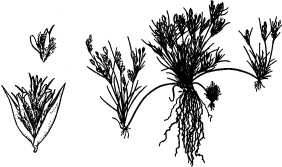
Occurrence
Most abundant on sandy and gravelly soils in the southern desert, western plateau, northern desert, and portions of the high and central plains. Usually associated with sites of low productivity. Found below 5,800 feet elevation.
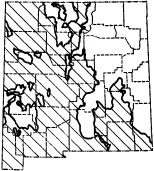
Forage Value and Management
Fluffgrass is usually grazed only on ranges suffering from feed shortages because the grass is probably less palatable than any other New Mexico range grass.
Grazing of fluffgrass indicates that too little forage is available. Therefore, stocking rates should be reduced to protect the livestock and the range.
Arizona Fescue
Festuca arizonica Vasey.
Description
Densely clustered stems. Seed stalks 1 to 3 feet tall. Gray-green to blue-green. Leaves slender, 6 to 20 inches long, stiff, and wiry with inrolled edges. Seedheads narrow, 3 to 6 inches long, with alternate, rough, erect branches.
Cool-season, perennial, bunch grass.
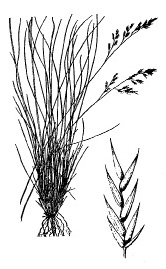
Occurrence
Throughout the mountain grasslands on most sites from 6,000 to 10,000 feet. Commonly associated with mountain muhly.
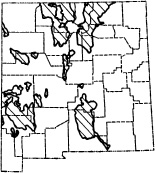
Forage Value and Management
Arizona fescue is palatable to cattle and horses, and moderately palatable to sheep. The grass produces large amounts of forage, and remains at least partly green from spring through fall.
Arizona fescue withstands moderate grazing well, but decreases rapidly under heavy use. It is, therefore, a good indicator or proper grazing management. Because of its heavy root system, the plant withstands drought well and is an excellent soil binder.
Sheep Fescue
Festuca ovina L.
Description
Vigorously growing, strongly rooted, 4 to 16 inches and occasionally 24 inches tall. Light to gray-green. The numerous leaves are basal, fine, inrolled, and tend to persist after death to form a compact clump 2 to 5 inches high. The seedheads are 2 to 4 inches long, usually open, and appear one-sided.
Cool-season, perennial, bunch grass.
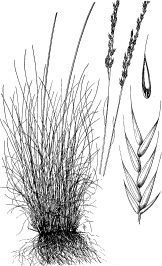
Occurrence
Subalpine meadows of mountain areas, sparse in timber stands above 8,000 feet.
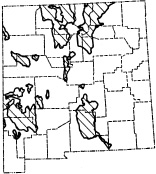
Forage Value and Management
Palatability of sheep fescue is high for all livestock, and where it grows, it usually produces the bulk of the forage. Livestock particularly relish the highly nutritious seedheads.
The plant stands up well under moderate grazing. It should not be grazed in the spring until the seedheads begin to show. When cattle graze this species, the stocking should permit summer-long use. Subalpine meadows in good condition contain an abundance of this grass.
Tanglehead
Heteropogon contortus (L.) Beauv.
Description
Coarse, tufted, 1 to 3 1/2 feet tall. Bright green when growing, orange-brown when cured. Leaves broad, creased down the middle, clasp the flattened stem at the base. Seeds sharply pointed at bases with long, coarse awns that twist together, black at maturity.
Warm-season, perennial, bunch grass.
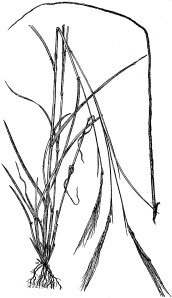
Occurrence
Southern desert. Most abundant on coarse gravelly and stoney soils at elevations between 3,800 and 8,500 feet.
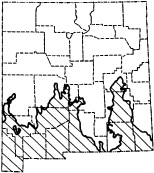
Forage Value and Management
As this species grows, it is moderately palatable to cattle and horses, and sheep will eat it. As it matures, tanglehead becomes coarse and unpalatable.
Ranges with abundant tanglehead should be used during the spring when the grass is most palatable. Ranges where tanglehead is sparse should be grazed on the basis of all the forage. Then tanglehead will be lightly grazed because of its low palatability.
Curlymesquite
Hilaria belangeri (Steud.) Nash.
Description
Small, fine-leaved, up to 1 foot tall. Bright bluish-green, curing to near white. Leaves flat, numerous, basal, and curl tightly as they cure. Seedheads are at the end of slender stalks. Seeds are chaffy, and leave a conspicuous zigzag stalk when they fall. Runners are long, slender, and aggressive. Both runner and stem joints hairy.
Warm-season, perennial, sod grass.
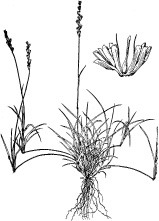
Occurrence
Most abundant in the southern and southwestern desert area. Most common on rocky, gravelly soils between 3,800 and 8,500 feet.
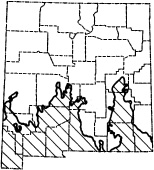
Forage Value and Management
Curlymesquite is highly palatable to all livestock. Although most nutritive when green, the grass cures well and remains palatable when dry.
The grass withstands heavy grazing, spreads rapidly by runners and seed, and is one of the last grasses to disappear on overgrazed ranges. It increases under grazing, and pure stands often indicate longtime heavy use. Because of its size, curlymesquite produces less forage than a mixed stand. Ranges with abundant curly-mesquite should be managed to increase or at least maintain the more productive associated grasses. Where curlymesquite is increasing, stocking should be lightened or grazing deferred occasionally during the growing season.
Galleta
Hilaria jamesii (Torr.) Benth.
Description
Coarse, bunchy, usually 1 to 2 feet tall. Tough, woody rootstalks sometimes 6 feet long. Dull blue-green, curing to light straw yellow. Stems erect with conspicuous hairs at the joint. Leaves mostly basal, stiff, straight, with the edges usually inrolled. Seeds hairy, chaffy, drop at maturity, leaving a zigzag stalk.
Warm-season, perennial, sod grass.
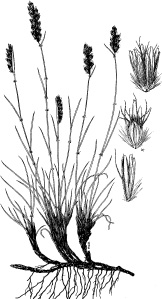
Occurrence
Most common in the northern two-thirds of the state. Important on the high plains in northwestern New Mexico, where it often forms pure stands. May grow on all sites from 3,500 to 7,500 feet in elevation.
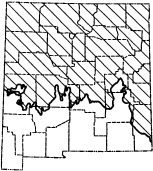
Forage Value and Management
During the summer, galleta affords moderately good forage for cattle and horses, and moderate forage for sheep. When dry, it is not palatable.
The grass should be grazed during the growing season. Galleta withstands heavy grazing well, but needs rest occasionally when grazed closely year after year. In seedings, this species is an excellent erosion control plant.
Tobosa
Hilaria mutica (Buckl.) Benth.
Description
Smooth-stemmed. One to 2 feet tall. Grows from coarse, scaly rootstock. Dull bluish-green, curing to gray. Leaves up to 6 inches long, stiff, harsh, and hairless. Seedheads erect, chaffy, broad, and white. The seeds drop, leaving a zigzag stem.
Warm-season, perennial bunchgrass.
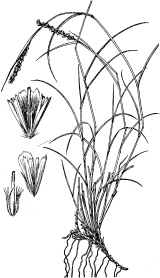
Occurrence
Throughout the southern desert, the southern portions of the western plateau, and the central and high plains at elevations of 3,000 to 6,500 feet. Grows best on areas subject to flooding. Often forms pure stands in swales that receive runoff water.
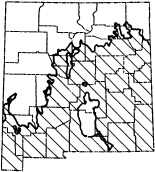
Forage Value and Management
While green and growing, tobosa is highly palatable to cattle and horses, and sheep will eat it. The species provides little winter feed.
Tobosa is fairly resistant to grazing. Its feed value is highest during the summer. Tobosa areas are often rotated with black grama areas for the winter. This keeps the black grama in top condition and does not injure the tobosa.
Removing old growth makes tobosa more palatable. This is often done by heavy grazing, burning, or mowing hay from it. Heavy grazing may injure the stand, however, and burning every third or fourth year is satisfactory only if the burned areas are allowed to regrow before being grazed.
Junegrass
Koeleria pyramidata (Lam.) Beauv.
Description
Slender, tufted, 1 to 2 1/2 feet tall. Bright green. Leaves, mostly basal, narrow, flat, sharply pointed, and rough on the upper surface. Seed stalks long. Seedheads narrow, dense, and tapered at both ends.
Cool-season, perennial, bunch grass.

Occurrence
Scattered throughout the northwestern portion of the state and mountain areas. Most abundant on coarse sandy or rocky soils at elevations from 5,500 to 10,000 feet.
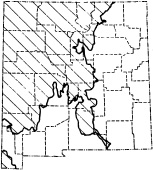
Forage Value and Management
The palatability of Junegrass is high for all livestock. The plant greens and matures early in the spring.
Because it greens early, Junegrass is often overgrazed. Care should be taken to avoid overuse if the grass is important on a range.
Green Sprangletop
Leptochloa dubia (H.B.K.) Nees.
Description
Coarse, erect, wiry-stemmed. Two to 3 feet tall. Bluish to dark green. Sheath often purple. Leaves either flat or folded at the midrib, and usually 1/8 to 1/4 inch wide. Seedheads branched from central stem, 15 slender, well-separated, drooping branches.
Warm-season, perennial, bunch grass.
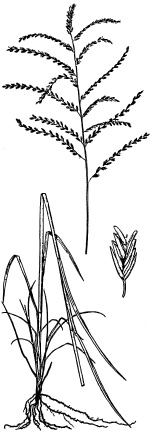
Occurrence
Throughout the southern desert and the southern portion of the western plateau and central plains. Generally on upland sites with coarse rocky or gravelly soils from 3,500 to 6,500 feet in elevation.
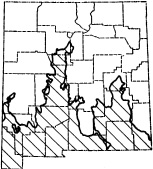
Forage Value and Management
Green sprangletop is usually palatable for all livestock. It grows most often with other grasses. The grass decreases quickly under heavy grazing, but is generally not considered an important forage species.
Wolftail (Texas Timothy)
Lycurus phleoides H.B.K.
Description
Densely tufted. One to 1 1/2 feet tall. Foliage somewhat like blue grama or hairy grama, with which it grows. Grayish-green, curing to grayish-straw. Leaves mostly basal, fine, and usually with white margins. Stems usually bent at the joints. Seedheads narrow, spike-like, 1 to 3 inches long.
Warm-season, perennial, bunch grass.
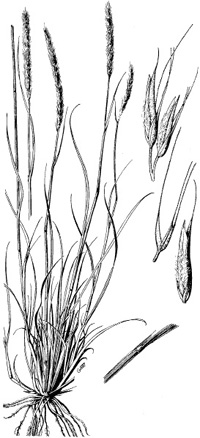
Occurrence
Scattered throughout the state on most sites. Most abundant on gravelly and stoney sites, below 8,500 feet in elevation.
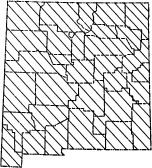
Forage Value and Management
Wolftail is moderately to highly palatable for all livestock. Although the plants green up some in early spring, they grow most after summer rains begin.
Wolftail is best used during the summer and spring. Unless grazing is moderate so that good seed crops are set, wolftail disappears rapidly under grazing.
Mountain Muhly
Muhlenbergia montana (Nutt.) Hitchc.
Description
Densely bunched. One to 2 feet tall. Light green, appearing purplish when seeds mature. Leaves mostly basal, rigid, and often inrolled and partially twisted. Seedheads narrow, loose, and somewhat one-sided. Flowers after summer rains.
Warm-season, perennial, bunch grass.
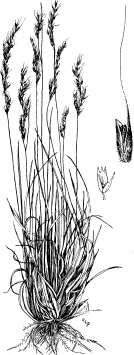
Occurrence
Northern, western, and mountain areas, on coarse cinder or stoney sites and in mountain meadows and grassland at 5,500 to 9,000 feet.
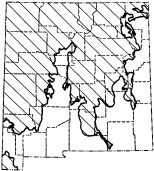
Forage Value and Management
Mountain muhly is palatable to all livestock, especially during the spring when the grass is green and succulent. Mountain muhly produces fairly large amounts of forage.
Mountain muhly, along with Arizona fescue, is most abundant in the ponderosa pine areas between meadows. Because meadow grasses are usually more palatable than mountain muhly, the meadows become overgrazed unless they are fenced. With fencing, ranchers can use both the mountain muhly and the meadow grasses, thus increasing the stocking and, at the same time, maintaining the grass.
Bush Muhly
Muhlenbergia porteri Scribn.
Description
Wiry and weak-stemmed. One to 3 feet tall. Stems leafy for entire length, many branched, bent at the joints. A tangled leafy mass when ungrazed. Purplish-green, curing to buff. Some stems remain green throughout the year. Leaves short and fine. Seedheads fine, loose, many branched, purplish to white.
Warm-season, perennial, bunch grass.
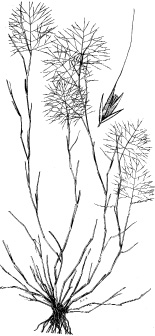
Occurrence
Throughout the southern desert and the southern portions of the western plateau, central plains, and high plains on most sites below 7,000 feet. Formerly common, but now found largely as individual plants under brush piles or shrubs.
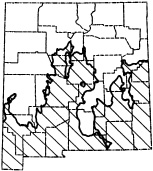
Forage Value and Management
Bush muhly is highly palatable to all livestock. If moisture is available, the grass will remain green through most of the year.
Bush muhly disappears rapidly when overgrazed on depleted ranges. Deferred grazing during July and August allows a full crop of seed to develop.
Mat Muhly
Muhlenbergia richardsonis (Trin.) Rydb.
Description
Grows in dense carpetlike patches. Up to 2 feet tall. Dull green while growing. Leaves usually inrolled and narrow with loose sheaths. Stems erect, wiry, and commonly bent at the joints. Seedheads narrow and contracted, 1/2 to 4 inches long, with few flowers.
Warm-season, perennial, sod grass.
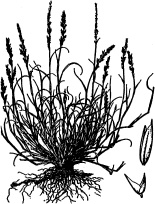
Occurrence
Most common in the northern two-thirds of the state. Typical on sandy, gravelly, and bottomland sites, and often on alkaline soils. Found at elevations of 5,000 to 7,400 feet.
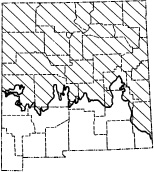
Forage Value and Management
Green mat muhly is palatable to cattle and horses and moderately palatable to sheep. The plant cures fairly well and is readily eaten by all livestock, although palatability is lowest when dry.
Mat muhly increases under grazing. Because of its sod-forming habit, the grass withstands heavy use well. It is usually found in scattered patches and is rarely abundant enough to be of any managerial importance.
Ring Muhly
Muhlenbergia torreyi (Kunth.) Hitchc.
Description
Tufted, dense. Up to 2 feet tall. As each tuft enlarges, the center (6 to 18 inches in diameter) dies. Leaves light green, mostly basal, strongly curved, densely matted, and up to 4 inches tall. Seedheads open and spreading, brownish-purple, with numerous seeds on fine, wavy branchlets. The purplish seeds are tipped with a fine awn.
Warm-season, perennial, sod grass.
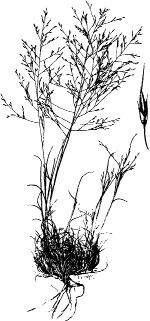
Occurrence
Throughout the state on coarse soils from 3,100 to 7,000 feet. Reaches its greatest abundance in the northern half of the state.

Forage Value and Management
Palatability is low to moderate for all livestock when the grass is green. Ring muhly is abundant on overgrazed ranges and thus is a good indicator of range condition. Since the species produces only a small volume of forage and its useful season is short, ring muhly ranges should be managed to restore better grasses.
Spike Muhly
Muhlenbergia wrightii Vasey.
Description
Often in individual bunches, 2 to 2 1/2 feet in diameter. Light green with gray to blackish seedheads and purplish leaf sheaths near the stem joints. Narrow, long leaves taper to sharp points. Seedheads, seldom over 1 foot tall, look somewhat like timothy, but often separate into distinct segments, especially the lower half.
Warm-season, perennial, bunch grass.
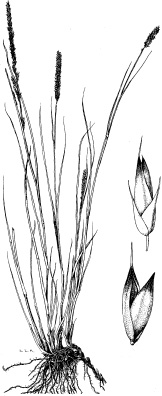
Occurrence
Northern and western portions of the state in mountains. Most abundant on rocky soils and in mountain meadows. Grows at elevations from 3,800 to 9,000 feet.
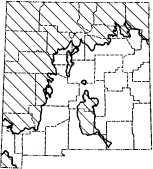
Forage Value and Management
Spike muhly rates high in palatability for all livestock.
Abundant spike muhly on rangeland in good condition needs only moderate grazing for maintenance. Depleted ranges may need summer deferment.
Indian Ricegrass
Oryzopsis hymenoides (Roem. & Schult.) Ricker
Description
Leafy, tufted. One to 2 feet tall. Rigid, erect stems. Dark green while growing, cures to a light straw color. Numerous long, slender, and inrolled leaves. Loose, widely spreading seedheads with main branches divided into two wavy branchlets, each supporting an oval, hairy, black seed at the end.
Warm-season, perennial, bunch grass.

Occurrence
Sandy and rocky sites in the southern desert, most sites in the northern desert and western plateau, sands and clays in the central plains, and shaly sites in the mountains. At elevations from 4,000 to 9,000 feet.
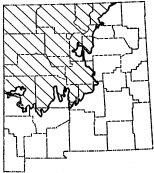
Forage Value and Management
Exceptional curing ability makes this grass palatable even in winter. The high protein content of seeds, which stay on the plant, is largely responsible for its winter feed value.
The grass should be grazed only lightly during the spring to allow maximum development of the seedheads. Areas supporting large stands are best grazed in winter.
Hall's Panicgrass
Panicum hallii Vasey.
Description
Tufted. Up to 3 feet tall. Light green to bluish-green while growing and straw-colored at maturity. Thin, mostly basal leaves are curled, with the appearance of wood shavings when dry. Open, erect seedheads. Seeds appear to be small nutlets.
Warm-season, perennial, bunch grass.
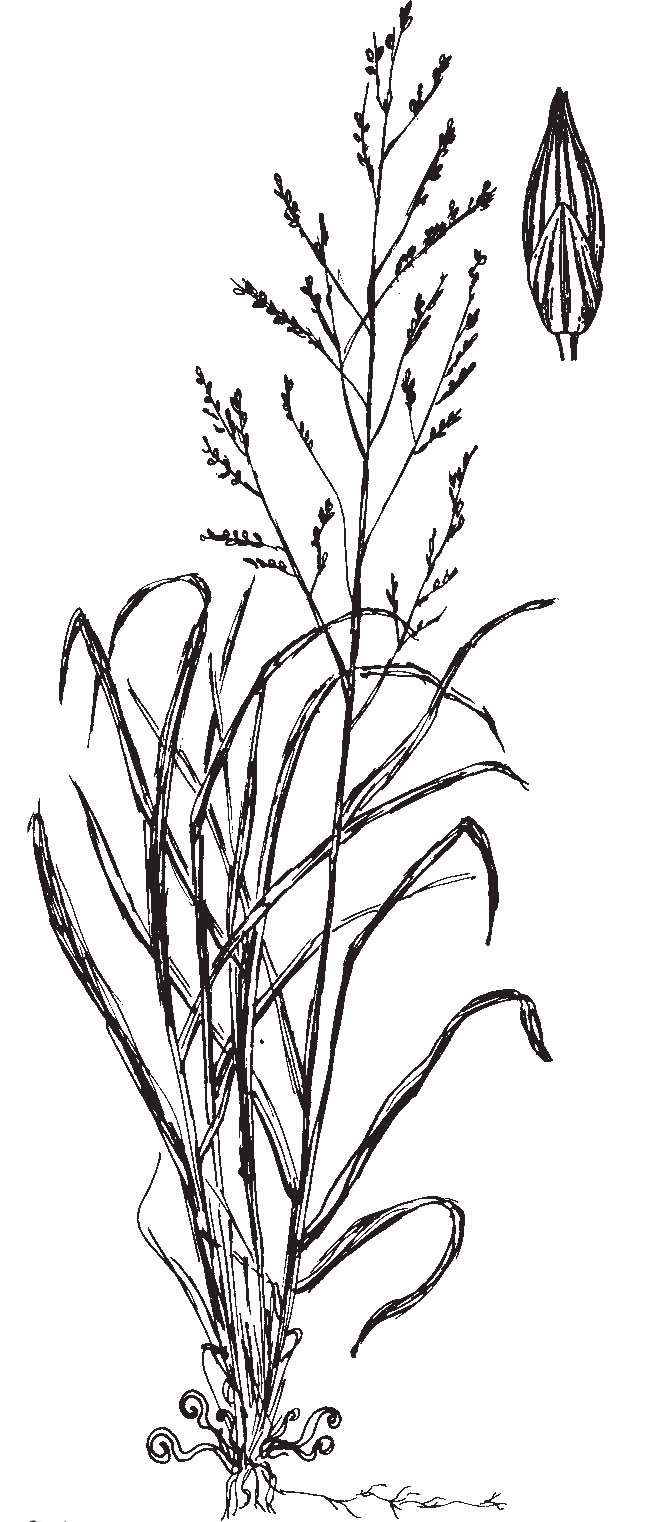
Occurrence
Scattered throughout the state except the northwestern and mountain areas. Common on coarse soils and bottomlands. Grows at elevations from 3,000 to 6,500 feet.
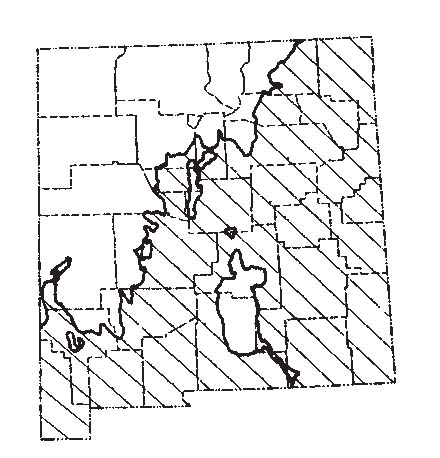
Forage Value and Management
Growing, Hall's panicgrass is highly palatable for all livestock. It retains this quality after curing because some leaves remain green most of the year.
Palatability causes the grass to decrease quickly under grazing even when associated grasses are properly utilized. Therefore, this species can be maintained only on areas reseeded as pure stands.
Vine Mesquite
Panicum obtusum H.B.K.
Description
Viney. One to 2 feet tall. Long, tough stolons with swollen, woolly joints. Light blue-green, curing to reddish-straw, then finally to grayish-tan. Leaves somewhat inrolled and up to 8 inches long. Seedheads in 2 to 6 branchlets, partially enclosed in the upper leaf sheath, and tightly pressed to the main stem. Large, blunt seeds.
Warm-season, perennial, sod grass.
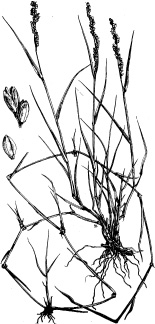
Occurrence
In the southern desert and southern portion of the western plateau, especially on sites with extra moisture. Also grows on loamy, clayey, and bottomland sites in the high and central plains, and scattered on bottomland sites in the northern portion of the western plateau and northern desert. Grows at elevations from 3,100 to 7,200 feet.
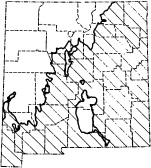
Forage Value and Management
Vine mesquite is usually fairly unpalatable, although livestock readily eat the fruiting heads. Because the grass forms sod vigorously, it is valuable for erosion control. The grass provides the best grazing in the summer since it is coarse at maturity. Light grazing permits the plant to spread rapidly. Since it is usually found on sites subject to erosion, vine mesquite should not be heavily grazed.
Mutton Bluegrass
Poa fendleriana (Steud.) Vasey.
Description
Also called muttongrass. Medium-sized. One to 2 feet tall. Bunches up to a foot or more in diameter. Leaves basal, pale, bluish-green, stiff, usually folded or with inrolled edges. Seedheads 1 to 4 inches long, erect, and densely flowered. Male and female parts commonly on separate plants.
Cool-season, perennial, bunch grass.
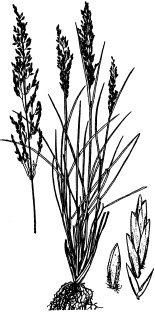
Occurrence
Common on well-drained soils in woodlands and forests within the mountain areas at 6,500 to 10,000 feet.
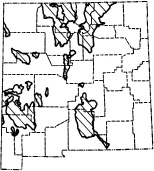
Forage Value and Management
Mutton bluegrass, highly palatable to all livestock, is particularly valuable as summer sheep feed. It begins to grow in late winter or early spring and provides abundant forage earlier than most other forage plants. The plant cures well and provides fair fall forage, although the palatability declines.
Because of its value, rangeland with abundant mutton bluegrass should be managed to maintain or improve the stand. Depleted areas, if rested during July and August in alternate years, can set seed and increase vigor.
Kentucky Bluegrass
Poa pratensis L.
Description
Low-growing. Numerous seed stalks, 1 to 3 feet tall, in tufts. Dark, shiny, green. Leaves 2 to 7 inches long, with boat-shaped tips. Seedheads pyramid-shaped, 1 to 4 inches long, and open. Base of individual flowers looks cobwebby.
Introduced, cool-season, perennial, sod grass.
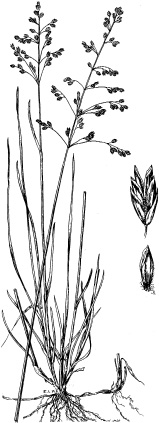
Occurrence
Mountain grasslands and wet meadows in portions of the central plains and western plateau at elevations of 6,500 to 10,000 feet.
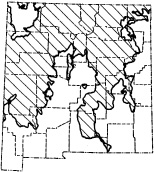
Forage Value and Management
Green Kentucky bluegrass is extremely palatable to all livestock. Growth begins early in the spring and provides good forage early.
This grass withstands continued heavy use better than most grasses. Under irrigation, nitrogen fertilization is required for maximum production. Because it spreads rapidly to form a dense cover, Kentucky bluegrass is valued as a soil stabilizer.
Little Bluestem*
Schizachyrium scoparium (Michx.) Nash
Description
Tufted and leafy. One to 4 feet tall, erect and slender. Bluish-green during growth and dark reddish-brown when cured. Stems flattened at the base. Several flower heads, each with a long stalk, on each stem. Seedheads slender and fuzzy.
Warm-season, perennial, bunch grass.
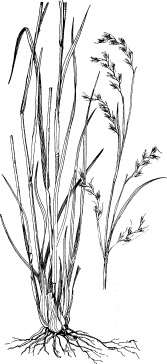
Occurrence
Rarely dominant on any site, but grows throughout the state from 3,000 to 9,000 feet.
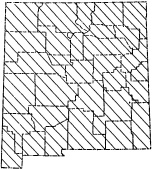
Forage Value and Management
The palatability of this grass during growth is low to moderate. The cured grass is rarely grazed. The species grows best when grazed during the growing season. Under heavy grazing, the plant decreases and is usually replaced by the gramas.
*Texas bluestem, Schizachyrium cirratum (Hack.) Woot. and Standi., is similar in appearance and environmental needs to little bluestem. The plant is smaller, 1 to 2 feet tall, and cures to a reddish- or purplish-brown.
Burrowgrass
Scleropogon brevifolius Phil.
Description
Creeping, with long, coarse, prostrate stems that often root at joints in moist soil. Light green, becoming silvery at maturity because of the numerous seedheads. Mostly basal, short, coarse leaves. Male and female seedheads on separate plants. Female seedheads have long, silvery, thread-like, twisted awns. Male seedheads are many flowered and awnless.
Warm-season, perennial, sod grass.
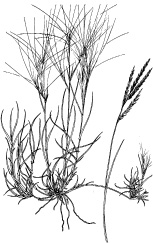
Occurrence
Commonly found on most sites in the southern desert. Common associate of tobosa grass on adobe clay soils of swales. Scattered throughout portions of the western plateau and central plains. Grows at elevations of 3,000 to 6,500 feet.
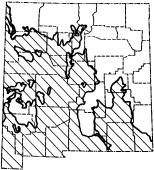
Forage Value and Management
Long, wiry awns and stiff, coarse leaves make burrograss unpalatable. Because this species increases under heavy grazing, its abundance on ranges indicates deterioration, and livestock numbers should be reduced, or grazing should be deferred and rotation established. Small infestations can be corrected by establishing water and salt away from the infested areas, or by fencing and reseeding the areas to more desirable grasses.
Plains Bristlegrass
Setaria leucopila (Scribn. & Merr.) K. Schum.
Description
Densely tufted. Bright green, curing to orange-brown. One to 4 feet tall. Stems often bend abruptly at the nodes. Leaves up to 1/2 inch wide, somewhat roughened on the upper surface, and curly after curing. Narrow, spikelike seedheads with stiff hairs extending from between the seeds.
Warm-season, perennial, bunch grass.

Occurrence
On most sites throughout the southern desert, portions of the western plateau, and on alkaline sites in parts of the central plains, at elevations of 3,000 to 7,000 feet.
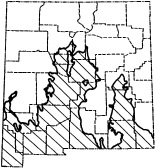
Forage Value and Management
Plains bristlegrass is moderately to highly palatable to all livestock, particularly the tender basal leaves. Under grazing, the plant decreases rapidly. It is often found growing in the open shade of small trees and brush where it is relatively protected from livestock.
Where plains bristlegrass is abundant, careful management will maintain it. Where other perennial grasses dominate, they should be considered first in management plans because plains bristlegrass cannot withstand grazing when other species are properly utilized.
Indiangrass
Sorghastrum nutans (L.) Nash.
Description
Tall. Four to 8 feet. Bluish-green, curing to dull straw. Leaves fairly wide, with a conspicuous claw-shaped ligule where the blade attaches to the sheath. Large, plume-like, golden seedheads.
Warm-season, perennial, bunch grass.

Occurrence
Scattered throughout the eastern portion of the state. Most common on sandy and bottomland sites between 3,700 and 7,000 feet.
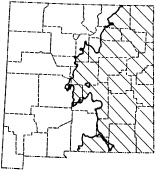
Forage Value and Management
Indiangrass is highly palatable while growing, but not after curing. The grass produces large amounts of forage.
Indiangrass decreases under heavy grazing. If continually grazed shorter than 5 to 8 inches, it is replaced by less productive plants. This grass is well adapted for irrigated permanent pasture since it produces large quantities of seed and forage, and is well suited for combining or hay production.
Alkali Sacaton
Sporobolus airoides Torr.
Description
Coarse, tough, long-lived. Up to 3 1/2 feet. Dense clumps up to 12 inches in diameter. Pale green with a slight grayish cast while growing. Abundant leaves, sometimes 18 inches long, inrolled at the points. Loose pyramidal seedheads with widely spreading branches.
Warm-season, perennial, bunch grass.
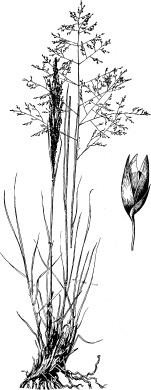
Occurrence
Found throughout the state at elevations of 3,100 to 7,500 feet, typical on alkaline soils of bottomlands and flats, and on sandy plateaus and washes.
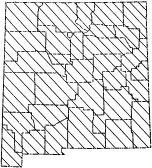
Forage Value and Management
Growing alkali sacaton is fairly palatable to cattle and horses and slightly less palatable to sheep. When the grass is dry it is poor forage.
Dense stands provide spring and summer grazing. If alkali sacaton is fully grazed in scattered stands, however, the other perennial grasses with which it grows will be overgrazed because they are more palatable. Therefore, this grass should be somewhat under-used.
Sand Dropseed
Sporobolus cryptandrus (Torr.) Gray.
Description
Erect, tufted, 1 1/2 to 4 feet tall. Stems leafy, with a ring of stiff, short white hairs at the junction of the stem and leaf. Bluish-green, curing to a light straw yellow. Leaves up to 12 inches long, at right angles to the stem, often frayed by the wind. Gray to purplish seedhead often enclosed in the uppermost leaf sheath. Portion not enclosed is spreading and open but narrow.
Warm-season, perennial, bunch grass.
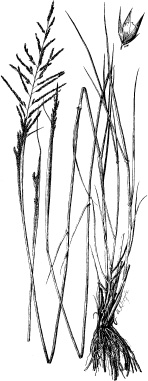
Occurrence
Throughout the state except in mountain areas. Most common in the southern desert and western plateau. Often on sand and gravelly sites, at 3,000 to 7,200 feet.

Forage Value and Management
Green sand dropseed is usually palatable to cattle and horses, and moderately so to sheep. The grass cures well and furnishes winter feed although it is less palatable when dry.
Sand dropseed increases under grazing. It provides better summer grazing than winter because of its low winter palatability.
Mesa Dropseed
Sporobolus flexuosus (Thurb.) Rydb.
Description
Tufted. Up to 2 feet. Smooth leaf sheaths with a conspicuous tuft of hairs where leaf and stem join. Bluish-green, curing to light straw yellow. Open or spreading seedheads, not often enclosed in a sheath, usually appear to be nodding.
Warm-season, perennial, bunch grass.
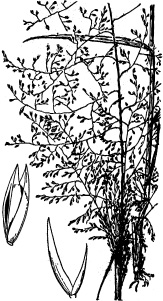
Occurrence
Common in the southern desert and southern portion of the central plains. Typical on sandy and gravelly sites at elevations of 3,000 to 6,800 feet.
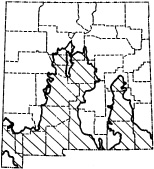
Forage Value and Management
Green mesa dropseed is moderately palatable to cattle, but the persistence of old growth usually interferes with its utilization. The sparse scattered stands are usually of little consequence in management.
Giant Sacaton
Sporobolus wrightii Monro.
Description
Large, coarse-stemmed, 3 to 6 feet tall. Clumps sometimes 3 feet in diameter. Pale grayish-green. Flat or partially inrolled leaves, up to one foot long. Open seedheads 1 to 2 feet long with many branchlets.
Warm-season, perennial, bunch grass.
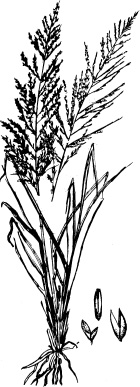
Occurrence
Found throughout the state except in mountain areas. Common on bottomlands and alluvial flats subject to flooding. Grows at elevations from 3,100 to 7,000 feet.
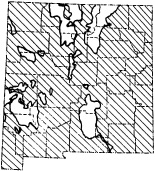
Forage Value and Management
Young, succulent sacaton is highly palatable, but the grass becomes coarse and tough at maturity.
Flats containing large amounts of sacaton are best grazed heavily in early spring. As grasses of other range areas begin to grow, livestock should be moved off the sacaton until fall. Coarse, unpalatable material is easily removed by burning every three or four years in early spring, just before growth beings.
Columbia Needlegrass
Stipa columbiana Macoun.
Description
Erect, fine-stemmed. One to 3 feet tall, with purplish nodes. Slender leaves, flat when growing, but inrolled at maturity, with a conspicuous ligule. Narrow, loose seedheads up to 8 inches long, and often purple in color. Bent awn twisted twice, usually 3/4 to 1 1/2 inches long.
Cool-season, perennial, bunch grass.
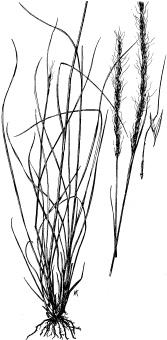
Occurrence
Meadows and valleys within the mountain areas at elevations from 6,500 to 8,500 feet.
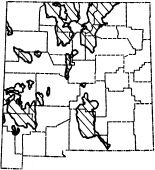
Forage Value and Management
Columbia needlegrass is highly palatable to cattle and horses, and moderately so to sheep. It usually remains green throughout the growing season. The grass tends to increase when more palatable blue grasses and wheatgrasses have been overgrazed.
Needle-and-Thread
Stipa comata Trin. & Rupr.
Description
Erect, tufted. One to 4 feet. Relatively few stems. Leaves often inrolled and pointed with a conspicuous ligule. Loosely spreading seedheads often partly enclosed in the upper sheath. Seeds tipped by long, prominent, twisted awns, shed soon after maturity.
Cool-season, perennial, bunch grass.
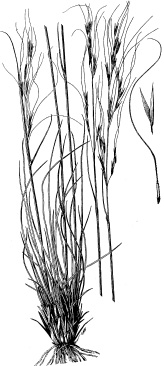
Occurrence
Scattered throughout the northern half of the state. Most common on sandy, gravelly, and foothill sites at elevations from 3,700 to 9,000 feet.
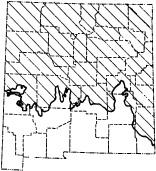
Forage Value and Management
The grass produces early spring forage and is highly palatable to all livestock before the seeds mature and after the seeds are shed. Mature seeds cause mechanical injury if grazed. On ranges where needle-and-thread is abundant, continued heavy spring grazing may reduce the stand.
New Mexico Feathergrass
Stipa neomexicana (Thurb.) Scribn.
Description
A tufted needle grass. Sixteen to 36 inches high. Blue-green leaf sheath, covered with tiny hairs. Rolled leaf blade up to 12 inches long. A long feathery awn on the seed distinguishes this grass from needle-and-thread.
Cool-season, perennial, bunch grass.
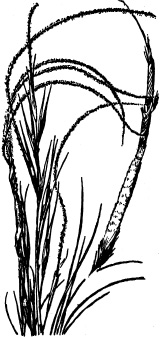
Occurrence
Most common on sandy, gravelly, and rocky sites in all areas of the state except the northern desert, the northern portion of the western plateau, and the mountains. Occurs at elevations from 3,100 to 7,200 feet.
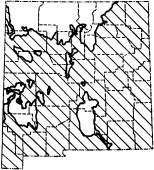
Forage Value and Management
New Mexican feathergrass provides moderate to good forage for all livestock. The sharp-pointed seeds, like needle-and-thread seeds, may injure the mouths of animals. The grass tends to decrease under grazing, especially on drier ranges. This grass withstands heavy use in the spring and fall and usually reproduces well if the plants are allowed to mature seed during summer.
Sleepygrass
Stipa robusta Scribn.
Description
Coarse, leafy, thick-bunched. Three to 6 feet tall. Bright green. Broad leaves, up to 2 feet long, hairy where the blade joins the stem. Densely flowered, pale green seedheads. Seeds covered with short, soft, white hairs terminated by a twice-bent awn about 1 1/2 inches long.
Cool-season, perennial, bunch grass.
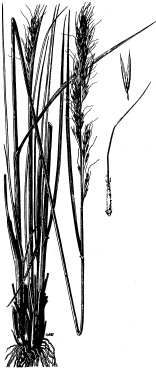
Occurrence
Throughout the northern and mountain areas of the state at elevations of 5,600 to 9,000 feet. Typical of coarse gravelly soils.
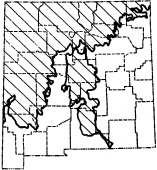
Forage Value and Management
Even when sleepygrass is green, it is not very palatable. Livestock graze it only when more palatable forage is absent.
Although the grass is said to have a narcotic or sleep-inducing effect on livestock, particularly horses, it does not cause death.
Sleepygrass increases under heavy grazing, and spreads quickly from its abundant seed supply. However, the grass is not aggressive when in competition with more preferred grasses under controlled grazing.
Forbs
Fringed Sagebrush (Estafiata)
Artemisia frigida Willd.
Description
Silvery-gray half-shrub with semi-herbaceous annual stems and a low, perennial, woody base. Four to 24 inches high. Small, silvery-hairy leaves, fringed, emit a sagelike odor when crushed. Numerous small, nodding, globe-shaped flower heads.
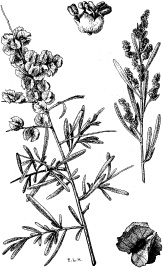
Occurrence
The high plains and central plains of northeastern New Mexico and the piñon-juniper zone of the mountain areas. Most common in full sunlight on dry gravelly, sandy, or loam soils, from 3,000 to 7,200 feet.
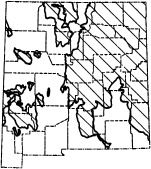
Forage Value and Management
This plant provides good to very good forage for sheep and goats and fair to good forage for cattle, especially in the late fall, winter, and early spring. It resists heavy grazing fairly well and will increase at the expense of desirable grasses, but may be killed by overgrazing. Moderate grazing will maintain a proper mixture of grass and fringed sagebrush.
Horsetail Milkweed (Whorled Milkweed)
Asclepias subverticillata (Gray) Vail
Description
Perennial, poisonous. Extensive horizontally spreading rootstocks can form new stems. Leaves narrow, 2 to 4 inches long, pale green, hairless, and in whorls of three to six at stem joints. Stems erect, usually one or two but sometimes five together. Both leaves and stems exude a milky sap when wounded. Small, greenish-white flowers form umbrella-shaped clusters.
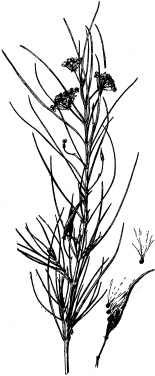
Occurrence
Most common in the northwest part of the state, especially on bottomland soils. Appears to be increasing in the southern desert area. Elevations of 4,500 to 8,000 feet.
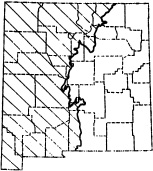
Forage Value and Management
This plant ranks among those most deadly to range livestock, especially sheep. Its palatability is quite low, but poisoning has been reported from ranges with plenty of desirable grass. Several species of milkweed, scattered throughout the state, are generally poisonous, but horsetail milkweed is the most common and causes the greatest losses.
Loco
Astragalus spp.*
Description
The group of poisonous plants known as locos or locoweed includes many species that differ widely in appearance. Most are perennials, although one important New Mexico species, Wooton loco (A. wootoni Sheldon), is an annual or biennial. Woolly loco (A. mollissimus Torr.) is also a common species in New Mexico. The locos are essentially stemless, with leaves made up of several leaflets which are usually silky hairy. Flowers look like those of the garden pea and vary from white through violet to purple. The dry fruit pod rattles with seeds. For more information, see Cooperative Extension Circular 557: A Guide to the Common Locoweeds and Milkvetches of New Mexico.
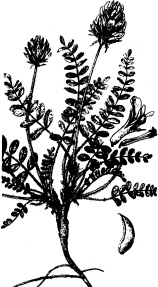
Occurrence
On most sites in the southern and northern desert, western plateau, and grassy parts of the higher mountains. Often increases on disturbed sites, but many also grow where grass cover is fairly dense. Found at elevations from 3,100 to 8,000 feet.
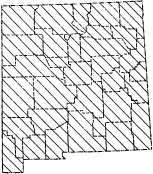
Forage Value and Management
Some locos are highly poisonous, and small amounts will kill an animal in a short time. Others can be consumed in fairly large amounts over a long period before ill effects are noticeable. Most loco poisoning occurs in early spring as these plants become green before forage plants. Locos are generally not very palatable, but animals, especially horses, appear to develop a taste for them.
*Lamberts crazyweed, Oxytropis lambertii Pursh., is very similar to the locos; however, it occurs primarily in the higher mountain areas.
Alfileria (Filaree)
Erodium cicutarium (L.) L'Her.
Description
An annual, heavily branched from the base, with finely divided, hairy leaves, which at first form a basal rosette but also appear on the stems when they develop. Leafy stems, 3 to 12 inches tall. Pinkish to purplish flowers, in umbrella-shaped clusters. Seeds are tipped with long tails that coil spirally at maturity.
A native of Europe, the plant was introduced to North America from the Mediterranean region.
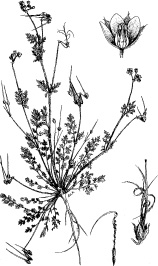
Occurrence
The southern desert, especially the southwestern portion of the state. Grows well on sandy soils. Occurs mostly below 5,000 feet.
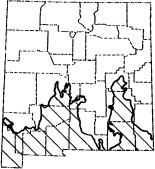
Forage Value and Management
This plant furnishes choice, highly palatable spring forage for all classes of livestock, as well as deer. In areas with some winter moisture it flourishes in early spring and is one of the first plants to appear. Its growth period is short, and it dries quickly after soil moisture is depleted. It tends to hug the ground under heavy grazing and thus protects itself by being less accessible.
Pingue (Colorado Rubberweed)
Hymenoxys richardsonii (Hook.) Cockerell
Description
Perennial. Thick taproots usually divide into several root crowns, each producing a branched, leafy stem 4 to 15 inches tall. Base is quite woolly at ground level. Leaves have 3 to 5 very narrow lobes, gland-dotted. Basal leaves with tufts of woolly hairs in the axils. Many yellow flower heads, about 1/2 inch across, in flat-topped clusters.
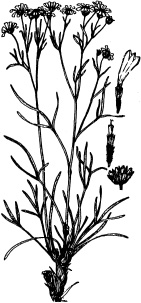
Occurrence
Most common in the northwestern portion of the state. Frequent in high mountain grassland, mostly at 4,500 to 7,500 feet, sometimes at 10,000 feet.
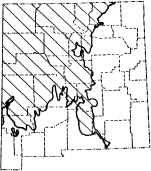
Forage Value and Management
Under normal conditions, pingue is not palatable for any livestock, although under extreme shortage of desirable forage it is grazed by sheep and goats, and to some extent by cattle. The plant is especially poisonous to sheep. In the areas where it occurs, pingue rapidly invades overgrazed ranges. The best control is grazing management that favors more palatable forage plants. They will gradually crowd out the pingue.
Woolly Indianwheat (Plantain)
Plantago patagonica Jacq.
Description
Small, silvery, annual. Two to 15 (mostly 6) inches tall. Dense, woolly, cylindrical flower head, 1 to 3 inches long. Basal, narrow leaves, covered with soft hairs.
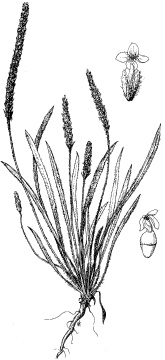
Occurrence
Fairly common in the southern desert and central and high plains areas. Grows on a wide variety of sites from heavy clay to sand, but seems to prefer loamy soils. Occurs mostly below 5,500 feet.
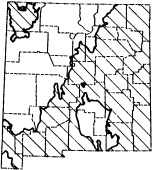
Forage Value and Management
Woolly indianwheat is fair to good forage for sheep and cattle on most ranges, but especially on desert lambing grounds. The seedheads are the most palatable part of the plant. Because the species is an annual, its abundance depends upon the amount of precipitation and the character and density of the perennial plant cover. Its production, therefore, is variable and should not be depended upon.
Russian Thistle (Tumbleweed)
Salsola kali L.
Description
Native of Eurasia. Prolific, annual. Introduced to North America from Europe. Grows rapidly to form a dense bushlike plant. One to 4 feet high. Very tender and juicy when young. Small, narrow, green leaves give a grasslike appearance. After flowering, the plant begins to dry and becomes quite harsh and brittle. Ridged stems often with reddish veins.
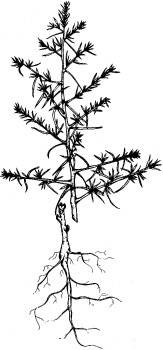
Occurrence
Fairly widespread over the state mostly at elevations below 6,000 feet. Grows best on sandy soils but also occurs on heavier types. A pest in cultivated areas.

Forage Value and Management
In early spring, Russian thistle rates as fair forage for all livestock, but it is worthless after maturity. It is quite drought-resistant. In emergencies it has been chopped and fed as fodder or silage. If fed alone, the plant has a very laxative effect on cattle.
Threadleaf Groundsel
Senecio longilobus Benth.
Description
Gray-white half-shrub. Conspicuous bright yellow flowers. One to 3 feet tall. Dense white hairs cover the foliage. Leaves deeply divided into long linear segments.
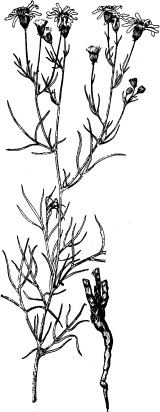
Occurrence
Most common in the southern desert, particularly on sandy and bottomland sites. Frequent along roadsides, sacrifice areas around stock tanks, and waste places. At elevations of 3,000 to 7,000 feet.
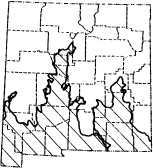
Forage Value and Management
Threadleaf groundsel has little or no forage value. It is considered poisonous, but because of its very low palatability it is probably not a source of danger on the range except during prolonged drought or on badly overgrazed areas.
Trees and Shrubs
Big Sagebrush*
Artemisia tridentata Nutt.
Description
Grayish, aromatic leaves, spatula-shaped, three-lobed. Varies greatly in size according to habitat. May reach 7 feet under favorable conditions. Good growth indicates deep, fertile, non-saline soil. Areas dominated by robust plants are often good sites for range seeding.

Occurrence
Found primarily in the northern desert and western plateau regions at elevations of 5,000 to 7,200 feet.

Forage Value and Management
Big sagebrush, although not very palatable, is grazed some. Sheep eat it on winter range, especially when snow covers the better plants. As a general rule this shrub will increase with heavy grazing.
*Sand sagebrush, Artemisia filifolia Torr., looks much like big sagebrush but is smaller (usually not over 3 feet tall), has very slender leaves, and is mostly restricted to the sandy solis of the state from 3,000 to 7,500 feet in elevation.
Fourwing Saltbush
Atriplex canescens (Pursh) Nutt.
Description
Also called chamiza. Grayish-white to pale green shrub, often with a scurfy coating on the foliage. Branches from ground level to occasional heights of 6 feet. Male and female flowers borne on separate plants. Seed has four conspicuous wings. Green throughout the winter.

Occurrence
Adapted to very diverse soil and climatic conditions. Most common on bottomland sites. Occurs in every region of the state except the mountain areas. Quite drought-resistant. Inhabits dry, saline, or alkaline soils. Found on most sites of the southern and northern deserts and western plateau.

Forage Value and Management
This is one of the most preferred shrubs of the Southwest. Leaves, stems, flowers, and seeds are grazed by all livestock except horses. Livestock so relish the seeds that they reduce reproduction of the plant. Prolonged use of more than 60 percent of the current growth will weaken and eventually kill the plant. This plant has been used in reseeding deteriorated range areas.
Shadscale
Atriplex confertifolia (Torr. & Frem.) Wats.
Description
Compact, spiny shrub. Dense clumps usually 1 to 2 feet high. Sharply spine-tipped branches, scurfy when young, smooth and straw-colored when old. Oval, gray, scurfy leaves 1/2 to 3/4 inch long. Almost round fruit, shaped like a wedge.
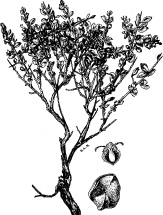
Occurrence
Most common in the northern desert and western plateau. Frequently inhabits alkali soils and dry valleys, extending up slopes and dry washes into foothill areas. At elevations of 4,000 to 7,000 feet.
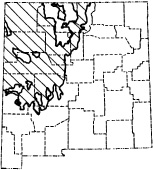
Forage Value and Management
Shadscale is palatable to all livestock, but it is particularly valuable as fall, winter, and spring browse on sheep ranges. The shrub is often less palatable than the grasses with which it occurs. Overgrazing on much of the winter range, however, has increased its use. Stands of this plant are easily maintained with moderate grazing.
Winterfat
Ceratoides lanata (Pursh) J.T. Howell
Description
Bushy-branched, semi-shrub. One to 3 feet tall. Many erect stems, woody at the base and herbaceous above, grow from the crown. Dense, woolly hairs, white at first, pale rust towards maturity, cover the twigs, leaves, and branches. Narrow leaves, about 1 inch long, with edges rolled under.
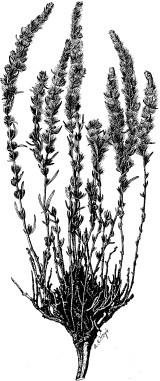
Occurrence
Widely distributed over the state but grows best in the southern and northern desert and western plateau areas. Found on most ranges at 3,000 to 7,500 feet in elevation and occasionally as high as 9,000 feet in mountain grasslands.
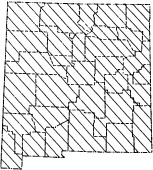
Forage Value and Management
As the name implies, winterfat is a valuable winter forage and furnishes much palatable and nutritious feed for cattle and sheep, as well as deer and elk. Chemical analysis shows it to be high in crude protein. Persistent overgrazing has greatly reduced this plant on many ranges and completely destroyed it on others. It responds well to regulated grazing, which allows the plant to reproduce and maintain its vigor.
True Mountain Mahogany*
Cercocarpus montanus Raf.
Description
Bushy shrub. Two to 10 feet high. Broadly oval leaves up to 2 inches long and 1 inch wide. Mostly evergreen. Leaves usually wedge-shaped at the base, edges triangularly toothed on the upper two-thirds, thickly veined, and hairy on the underside. Fruits have a feathery tail up to 4 inches long.
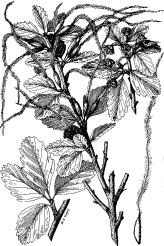
Occurrence
Most abundant at higher elevations in the piñon pine and juniper woodland and ponderosa pine zones of the mountains. Occurs on breaks and gravelly, stoney, and cinder sites at 4,500 to 9,500 feet in elevation.
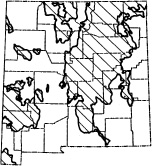
Forage Value and Management
True mountain mahogany rates as good to very good browse for all livestock. This is one of the most valuable winter feeds for deer. The plant withstands grazing well.
*Hairy mountain mahogany, Cercocarpus breviflorus Gray, is similar in forage value and distribution but has smaller leaves (about one inch long or less) with smooth edges.
Rubber Rabbitbrush
Chrysothamnus nauseosus (Pall,) Britton
Description
Deep-rooted, much-branched shrub. Twenty to 40 inches tall. Small, yellow flower heads clustered at the ends of stems. Narrow-linear leaves, 1 to 3 inches long, less than 1/8 inch wide, gray-green. Stems often white and felty with a grayish cast. Contains a high-grade rubber called chrysil, especially in the lower woody portions.
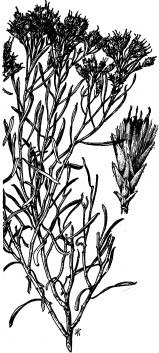
Occurrence
Throughout the northwestern part of the state, on breaks and gravelly, rocky, and bottomland sites in the southern desert. Also at high altitudes in the mountain areas, from 5,500 to 8,000 feet.
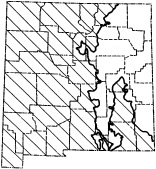
Forage Value and Management
Under normal conditions this plant has little or no forage value. All classes of stock graze the flowertops lightly and occasionally eat small amounts of leaves and young stems from September to November. Heavy grazing usually indicates an overstocked range.
Longleaf Mormon Tea (Joint Fir, Ephedra)
Ephedra trifurca Torr. *
Description
Scraggly shrub. Three to 5 feet tall. Slender branches, ranging from dark green to yellow-green, are tipped with a weak spine. Leaves 1/4 to 1/2 inch long, brownish, three at each stem joint. Grooved or ridged twigs are opposite or clustered at stem joints. The plant was used as a medicine as well as a beverage by Indians, Spanish, and early settlers.
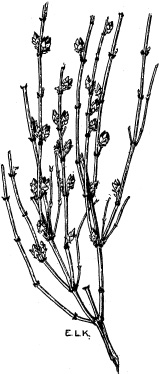
Occurrence
Most common on open sandy sites in the southern desert and sandy sites and breaks in the northwestern parts of the state. Also found on gyp sites in central portion. Grows at elevations of 3,000 to 7,500 feet.
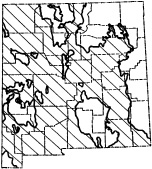
Forage Value and Management
Mormon tea ranks quite low in forage value, although it is frequently browsed in such emergency periods as extended drought.
*Torrey Mormon tea, Ephedra torreyana Wats., is a common associated species that is very similar in distribution and value. The scale leaves of Torrey Mormon tea are usually shorter, less than 1/6 inch long.
Apache Plume
Fallugia paradoxa (D. Don) Endl.
Description
Many-branched, often evergreen shrub. Usually 2 to 3 feet tall but occasionally 6 to 7 feet under very favorable conditions. Large, white showy flowers resemble a wild rose. Soft-hairy seeds have many feathery tails, sometimes 2 inches long. These turn reddish with age. Clustered leaves are divided into 3 to 7 linear lobes.
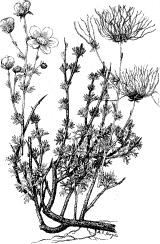
Occurrence
Most common in the southern desert and western plateau under a wide range of conditions, from rocky or gravelly slopes to alluvial plains. Grows best in deep, moist bottomland, such as open canyon bottoms, and on the sides of arroyos. Altitudes from 4,800 to 7,500 feet.
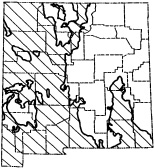
Forage Value and Management
In general, Apache plume is considered good forage for all livestock, especially as winter browse for deer. It withstands close grazing well and recuperates quickly when given a rest.
Tarbush
Flourensia cernua DC.
Description
Many-branched shrub. Three to 6 feet tall. Small, thick, alternate leaves. Exudes a resinous substance. Yellowish, bell-shaped flowers have a nodding or drooping appearance.

Occurrence
Mesas and slopes of the dry southern portions of the state, often on limestone soils. Also common on some bottomland sites and the fringe areas of tobosa grass swales. At elevations of 3,000 to 6,500 feet.
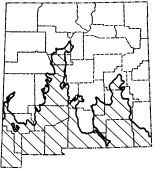
Forage Value and Management
Tarbush is unpalatable to all livestock. It increases as overgrazing reduces forage plants, until it is now the dominant plant on most of the adapted sites.
Creosote Bush
Larrea tridentata (DC.) Coville
Description
Many-branched shrub. Leaves small, shiny, evergreen. Most characteristic of the southern desert of New Mexico. Three to 6 feet tall. Yellow flowers. Hairy, bluish fruit. Stems gray with black bands. Strong creosote-like odor, especially when burned or after a rain.
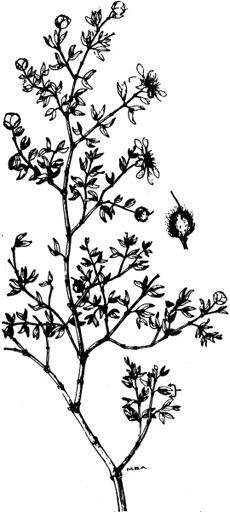
Occurrence
The southern desert at elevations of 3,000 to 7,000 feet. Often forms pure stands of uniformly spaced plants on the sandy or gravelly soils of mesas and hill-sides. Extremely well adapted to severe climatic and soil conditions.
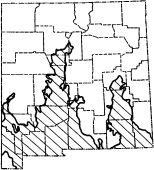
Forage Value and Management
Creosote bush is important chiefly because of its abundance. It is worthless as forage. Usually very little palatable vegetation grows in a creosote bush stand.
The creosote bush area of the Southwest has increased tremendously since the introduction of domestic livestock. The combination of over-grazing and cessation of fires seems to be responsible for the increase.
Cacti
Opuntia spp.
Description
One to 10 feet tall. Generally classed as shrubs. Characterized by joint stems which may be round as in cholla cactus or flattened as in the prickly pear. Leaves small, fleshy, inconspicuous, with many bristles at the bases. Stems covered with barbed spines. Flowers bright, yellow, orange, red, or purple. Fruit usually reddish or purplish, fleshy, often spiny, with many hard seeds.
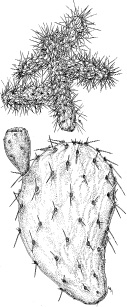
Occurrence
Widely distributed and very abundant on some ranges. Found on most sites and soils throughout the state, except in the high mountain areas. Least common on gyp and seldom on salty areas. Grow at elevations of 3,000 to 7,500 feet.
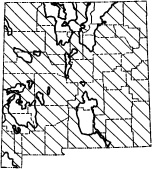
Forage Value and Management
Cacti are used as emergency feed for cattle and sheep during prolonged drought. During emergencies, the spines are singed off to make accessible the fleshy joints, which are palatable to cattle and sheep. Under normal conditions, cacti are grazed only slightly but serve as important food for rabbits and rodents.
Both the prickly pear and cholla cacti increase under heavy grazing. They are often grubbed out to reduce heavy infestations, which decrease grass production.
Mesquite
Prosopis glandulosa Torr.
Description
Thorny shrub or tree. Usually 2 to 10 but sometimes 50 feet tall. Deciduous. Dark green leaves, divided into many small leaflets. Cream-colored flowers develop into pods 4 to 8 inches long. Drought resistant. Roots sometimes grow to a depth of 60 feet.
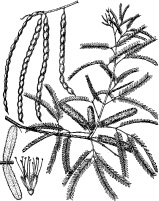
Occurrence
Most common in the southern desert. Found in bottomland areas of the high plains and central plateau. Grows at elevations of 3,000 to 8,500 feet.
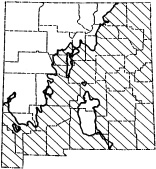
Forage Value and Management
Much of the state now occupied by mesquite was formerly grassland. Prolonged abusive grazing has killed the grass, and mesquite has taken its place. The plant is aggressive, adapted to a wide range of habitats, and extremely hardy. The leaves are grazed only when there is no other forage, but the beans are sought out and eaten avidly, presumably because of their high sugar and protein content. No doubt dissemination of undigested seeds by livestock has spread mesquite.
This plant can be controlled with certain chemicals now on the market.
Oak Brush
Quercus spp.
Description
Shrubs or small trees. Leaves dark green, persistent, generally deeply lobed. Acorns usually less than 1 inch long. Bark of main branches rough or flaky.
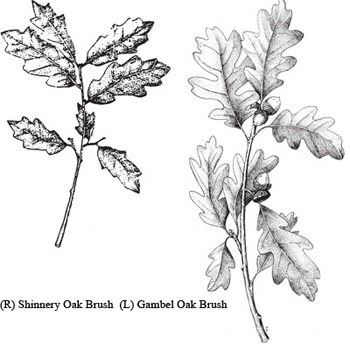
Occurrence
Shinnery oak (Quercus havardii Rydb.) occurs on sandy soils at elevations generally below 4,000 feet, mostly in the southeastern part of the state. Gambel oak (Q. gambelii Nutt.) commonly grows in piñon-juniper and ponderosa pine areas at elevations of 4,800 to 9,000 feet.
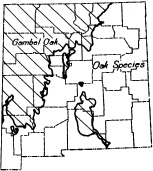
Forage Value and Management
The leaves of oak brush provide valuable forage for sheep and goats. Cattle browse oak leaves some. An exclusive oak leaf diet, however, results in sickness and sometimes death among cattle and lambs. The acorns constitute an important food for various wild game such as deer, elk, and turkey, as well as smaller mammals.
Skunkbrush Sumac
Rhus trilobata Nutt.
Description
Many-branched shrub. Two to 7 feet tall. Conspicuously 3-lobed leaves have a disagreeable odor when crushed. Bright red berrylike fruits, acid to taste, were often eaten by Indians.
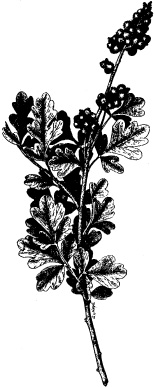
Occurrence
Widely distributed over the state except for the northwestern high desert regions. Most commonly inhabits rocky, gravelly, or sandy sites and frequently bottomland areas from 3,100 to 9,000 feet.
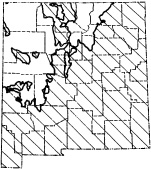
Forage Value and Management
The palatability of skunkbrush is distinctly low, but both cattle and sheep will graze it when lacking more palatable herbaceous vegetation. Palatability is rated much higher for goats.
Broom Snakeweed
Xanthocephalum sarothrae (Pursh) Skinners.
Description
Also called snakeweed, broomweed, and turpentine-weed. Semi-shrub. One to 2 feet tall. Woody base. Stems numerous, lower portions somewhat woody, but mostly herbaceous, unbranched except for flower-bearing branchlets near top. Bright green, very narrow leaves 1/2 to 1 1/2 inches long. Small, yellow flowers in flat-topped clusters on stem ends.

Occurrence
In most areas of the state. Grows best on dry plains and slopes of the southern and northern deserts and the western plateau. Ranges in altitude from 3,000 to 8,000 feet, occasionally above 9,000 feet in mountain grasslands.
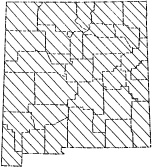
Forage Value and Management
This plant is nearly worthless as forage for cattle, but sheep graze the young succulent foliage when more palatable plants are scarce. Broom snakeweed aggressively invades livestock ranges where the better forage grasses have been depleted or destroyed by overgrazing. Consumption of large quantities of this plant is reported to cause abortion in range cows.
Yucca
Yucca spp.
Description
Shrubs. Bases and stems heavy. Leaves slender, daggerlike, spine-tipped. Large flowers with creamy white petals bloom in large clusters on stalks rising from the center of the plant. Striking plants, most frequently associated with the desert in art and literature.
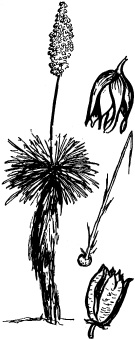
Occurrence
Yucca elata Engelm., or soaptree yucca, is most common in the southern desert. Often associated with black grama or former black grama range. Grows on stalks 3 to 20 feet tall (occasionally 30). Y. glauca Nutt., small soapweed, is found primarily in the high plains and central plateau. It is usually less than 4 feet tall and does not grow on stalks.
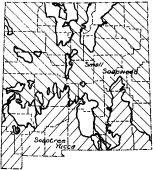
Forage Value and Management
The main grazing value of the yuccas is the highly palatable, succulent flowers produced in May and June. During prolonged drought, the plants serve as valuable emergency maintenance feed when chopped or shredded and fed with protein supplement.
Bibliography
Correll, D.S. and M.C. Johnston. 1970. Manual of the vascular plants of Texas. Texas Research Foundation. 1881 pp.
Dodge, N.N. 1958. Flowers of the southwest deserts. Southwestern Monuments Association. 112 pp.
Gould, F.W. 1975. Grasses of Texas. Texas A & M University Press. 653 pp.
Gouid, F.W. 1951. Grasses of the Southwestern United States. Univ. of Arizona Press. 352 pp.
Hitchcock, A.S. 1950. Manual of the grasses of the United States, [USDA Mis. Pub. 200.] U.S. Government Printing Office. 1051 pp.
Humphrey, R.R. 1955. Forage production on Arizona ranges, IV. Coconini, Navajo, Apache Counties. Ariz. Agr. Exp. Sta. Bul. 226. 84 pp.
Humphrey, R.R. 1960. Arizona range grasses. Ariz. Agr. Exp. Sta. Bul. 298.
Humphrey, R.R. 1960. Forage production on Arizona ranges V. Pima, Pinol, and Santa Cruz Counties. Ariz. Agr. Exp. Sta. Bul. 302. 137 pp.
Judd, I.B. 1962. Principal forage plants of southwestern ranges [Rocky Mountain Forest and Range Exp. Sta. Paper 69]. USDA Forest Service, Fort Collins, Colorado. 93 pp.
Kearney, T.A., and R.H. Peebles. 1960. Arizona flora. Univ. of California Press. 1085 pp.
USDA Forest Service. 1937. Range plant handbook. U.S. Government Printing Office.
USDA Forest Service. Rocky Mountain Forest and Range Exp. Sta. 1976. Principal range plants of the central and southern Rocky Mountains: Names and symbols. Fort Collins, Colorado. 121 pp.
USDA Soil Conservation Service. 1962. Range site technical descriptions and range condition guides for New Mexico. Albuquerque, New Mexico.
Valentine, J.P. Important Utah range grasses. Utah State Univ. Ext. Cir. 281. 48 pp.
Wooten, E.O. and P.C. Standley. 1915. Flora of New Mexico. U.S. Government Printing Office. 794 pp.
Acknowledgements
Appreciation is expressed to the Agricultural Experiment Station, University of Arizona, Texas Agricultural Experiment Station, Texas A&M University, and the Herbarium of the U.S. Forest Service for furnishing the drawings of various plants.
Plant names follow Correll and Johnston's Manual of the Vascular Plants of Texas and Gould's Grasses of Texas. The Soil Conservation Service's Range Site Technical Descriptions and Range Condition Guide for New Mexico was used in determining distribution, sites and elevation ranges for the plant species.
Original authors: Charles W. Gay, Jr., Extension range management specialist; and Don D. Dwyer, professor of range management. Subsequent revisions by Robert E. Steger, Extension range management specialist; Stephan Hatch, assistant professor of range management; and Jerry Schickedanz, coordinator, Range Improvement Task Force and former Dean and Chief Administrative Officer of the College of Agricultural, Consumer and Environmental Sciences.

Christopher D. Allison is Department Head of the Department of Extension Animal Sciences and Natural Resources at NMSU. Chris earned his Ph.D. in range science from Texas A&M University. He is a range management specialist with interest and expertise in range animal nutrition, grazing management, and plant toxicology.
To find more resources for your business, home, or family, visit the College of Agricultural, Consumer and Environmental Sciences on the World Wide Web at pub.nmsu.edu.
Contents of publications may be freely reproduced for educational purposes. All other rights reserved. For permission to use publications for other purposes, contact pubs@nmsu.edu or the authors listed on the publication.
New Mexico State University is an equal opportunity/affirmative action employer and educator. NMSU and the U.S. Department of Agriculture cooperating.
Reviewed by Casey Spackman, 2023, Las Cruces, NM.


